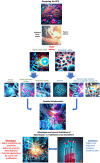Liquid biopsy for early detection of hepatocellular carcinoma
- PMID: 37809326
- PMCID: PMC10556479
- DOI: 10.3389/fmed.2023.1218705
Liquid biopsy for early detection of hepatocellular carcinoma
Abstract
Hepatocellular carcinoma (HCC) is a highly prevalent and lethal cancer globally. Over 90% of HCC cases arise in the context of liver cirrhosis, and the severity of the underlying liver disease or advanced tumor stage at diagnosis significantly limits treatment options. Early diagnosis is crucial, and all guidelines stress the importance of screening protocols for HCC early detection as a public health objective. As serum biomarkers are not optimal for early diagnosis, liquid biopsy has emerged as a promising tool for diagnosis, prognostication, and patients' stratification for personalized therapy in various solid tumors, including HCC. While circulating tumor cells (CTCs) are better suited for personalized therapy and prognosis, cell-free DNA (cfDNA) and extracellular vesicle-based technologies show potential for early diagnosis, HCC screening, and surveillance protocols. Evaluating the added value of liquid biopsy genetic and epigenetic biomarkers for HCC screening is a key goal in translational research. Somatic mutations commonly found in HCC can be investigated in cfDNA and plasma exosomes as genetic biomarkers. Unique methylation patterns in cfDNA or cfDNA fragmentome features have been suggested as innovative tools for early HCC detection. Likewise, extracellular vesicle cargo biomarkers such as miRNAs and long non-coding RNAs may serve as potential biomarkers for early HCC detection. This review will explore recent findings on the utility of liquid biopsy for early HCC diagnosis. Combining liquid biopsy methods with traditional serological biomarkers could improve the overall diagnostic accuracy for early HCC detection.
Keywords: cell free DNA; early diagnosis; extracellular vesicles; hepatocellular carcinoma; liquid biopsy.
Copyright © 2023 Manea, Iacob, Iacob, Cerban, Dima, Oniscu, Popescu and Gheorghe.
Conflict of interest statement
The authors declare that the research was conducted in the absence of any commercial or financial relationships that could be construed as a potential conflict of interest.
Figures
Similar articles
-
Utility of Liquid Biopsy Analysis in Detection of Hepatocellular Carcinoma, Determination of Prognosis, and Disease Monitoring: A Systematic Review.Clin Gastroenterol Hepatol. 2020 Dec;18(13):2879-2902.e9. doi: 10.1016/j.cgh.2020.04.019. Epub 2020 Apr 11. Clin Gastroenterol Hepatol. 2020. PMID: 32289533 Free PMC article.
-
Genomic Landscape of Liquid Biopsy for Hepatocellular Carcinoma Personalized Medicine.Cancer Genomics Proteomics. 2021 May-Jun;18(3 Suppl):369-383. doi: 10.21873/cgp.20266. Epub 2021 May 15. Cancer Genomics Proteomics. 2021. PMID: 33994362 Free PMC article. Review.
-
Genome-wide discovery and validation of diagnostic DNA methylation-based biomarkers for hepatocellular cancer detection in circulating cell free DNA.Theranostics. 2019 Sep 25;9(24):7239-7250. doi: 10.7150/thno.35573. eCollection 2019. Theranostics. 2019. PMID: 31695765 Free PMC article.
-
Biomarkers for diagnosis and therapeutic options in hepatocellular carcinoma.Mol Cancer. 2024 Sep 6;23(1):189. doi: 10.1186/s12943-024-02101-z. Mol Cancer. 2024. PMID: 39242496 Free PMC article. Review.
-
Liquid biopsy by combining 5-hydroxymethylcytosine signatures of plasma cell-free DNA and protein biomarkers for diagnosis and prognosis of hepatocellular carcinoma.ESMO Open. 2021 Feb;6(1):100021. doi: 10.1016/j.esmoop.2020.100021. Epub 2021 Jan 25. ESMO Open. 2021. PMID: 33508734 Free PMC article.
Cited by
-
Hepatocellular Carcinoma Surveillance Strategies: Major Guidelines and Screening Advances.Cancers (Basel). 2024 Nov 24;16(23):3933. doi: 10.3390/cancers16233933. Cancers (Basel). 2024. PMID: 39682122 Free PMC article. Review.
-
The current status and future directions of artificial intelligence in the prediction, diagnosis, and treatment of liver diseases.Digit Health. 2025 Apr 13;11:20552076251325418. doi: 10.1177/20552076251325418. eCollection 2025 Jan-Dec. Digit Health. 2025. PMID: 40290269 Free PMC article. Review.
-
Single-Gene Mutations in Hepatocellular Carcinoma: Applications and Challenges in Precision Medicine.Int J Med Sci. 2025 Jul 10;22(13):3268-3276. doi: 10.7150/ijms.117603. eCollection 2025. Int J Med Sci. 2025. PMID: 40765562 Free PMC article. Review.
-
Preliminary Evaluation of Plasma circ_0009910, circ_0027478, and miR-1236-3p as Diagnostic and Prognostic Biomarkers in Hepatocellular Carcinoma.Int J Mol Sci. 2025 May 19;26(10):4842. doi: 10.3390/ijms26104842. Int J Mol Sci. 2025. PMID: 40429981 Free PMC article.
-
Extracellular Vesicle microRNA: A Promising Biomarker and Therapeutic Target for Respiratory Diseases.Int J Mol Sci. 2024 Aug 23;25(17):9147. doi: 10.3390/ijms25179147. Int J Mol Sci. 2024. PMID: 39273095 Free PMC article. Review.
References
-
- Ferlay J, Ervik M, Lam F, Colombet M, Mery L, Piñeros M. et al. Global Cancer observatory: Cancer today. (2020). Lyon, France: International Agency for Research on Cancer Available at: https://gco.iarc.fr/today (accessed April 1, 2023).
Publication types
LinkOut - more resources
Full Text Sources
Research Materials


